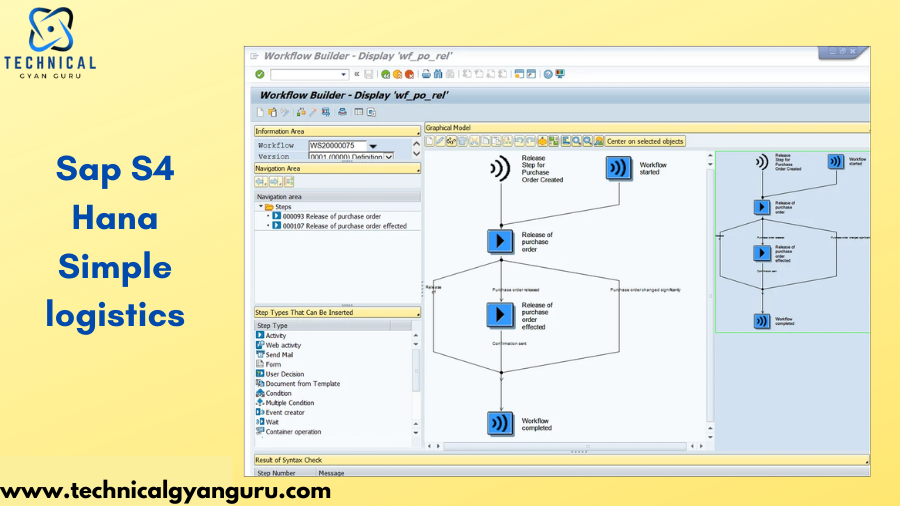
Unleash the power of SAP S/4HANA for a simplified yet powerful logistics experience. Discover how SAP S/4HANA Simple Logistics optimizes processes, boosts efficiency, and unlocks real-time insights… Read More!**
Frustrated by sluggish supply chains and skyrocketing logistics costs? In today’s hyper-competitive business landscape, a streamlined and efficient logistics operation is no longer a luxury – it’s a necessity. Enter SAP S/4HANA Simple Logistics, a revolutionary solution designed to transform your supply chain from a tangled mess into a well-oiled machine. This powerful combination of SAP’s next-generation HANA database and a focus on core functionalities simplifies processes, unlocks real-time data insights, and empowers you to make smarter decisions – faster. Ready to ditch the frustration and embrace a future of streamlined logistics? Let’s dive into the world of SAP S/4HANA Simple Logistics and discover how it can revolutionize your business!
Unpacking the Power of SAP S/4HANA Simple Logistics:
At the heart of SAP S/4HANA Simple Logistics lies a powerful combination of innovative technology and a focus on core functionalities. Let’s delve deeper into the key features that make this solution a game-changer for modern supply chains:
The HANA Advantage:
Traditional logistics systems often struggle with slow data processing and limited real-time insights. SAP S/4HANA Simple Logistics shatters these limitations by leveraging the in-memory computing capabilities of the SAP HANA database. Imagine a system where data is stored and accessed directly from memory, eliminating the need for slow disk drives. This translates to lightning-fast processing speeds, real-time data availability, and the ability to analyze vast amounts of information instantaneously. With SAP HANA, complex logistics queries that used to take hours are now completed in seconds, empowering you to make data-driven decisions with unprecedented speed and accuracy.
For instance, imagine a scenario where a sudden surge in demand for a specific product throws your entire inventory management system into a frenzy. With traditional systems, you might be left scrambling for accurate stock levels, potentially leading to stockouts or overstocking. However, SAP S/4HANA Simple Logistics provides real-time visibility into your inventory levels across all locations. This allows you to react instantly, reallocate resources efficiently, and fulfill customer orders seamlessly.
A Simplified Data Model:
Gone are the days of complex and redundant data structures that plague traditional logistics systems. SAP S/4HANA Simple Logistics boasts a streamlined data model, eliminating unnecessary data duplication and simplifying information management. This not only reduces storage requirements but also improves data consistency and accuracy. Less time spent wrangling complex data structures translates to more time spent focusing on strategic optimization and innovation.
Furthermore, the simplified data model makes it easier for users to navigate the system and access the information they need quickly and efficiently. This translates to improved user adoption, reduced training times, and a more empowered workforce capable of leveraging the full potential of the system.
Benefits and Use Cases: Unleashing the Power of Streamlined Logistics
The transformation potential of SAP S/4HANA Simple Logistics extends far beyond its innovative technology. Let’s explore some of the key benefits this solution offers and delve into real-world examples of how companies have leveraged its power to achieve significant improvements:
Enhanced Visibility and Transparency:
One of the most significant advantages of SAP S/4HANA Simple Logistics is the dramatic improvement in supply chain visibility. Real-time data access across all logistics functions, from inventory levels to shipment tracking, empowers you to gain a holistic view of your entire supply chain. No more working with outdated information or struggling to reconcile data from disparate systems. With SAP S/4HANA Simple Logistics, you have a single source of truth, enabling you to proactively identify potential bottlenecks, optimize resource allocation, and make informed decisions based on the latest data.
For instance, a leading automotive manufacturer utilized SAP S/4HANA Simple Logistics to gain real-time visibility into their global parts inventory. This newfound transparency allowed them to identify and eliminate excess stock in certain regions while ensuring critical parts were readily available at production facilities. As a result, the company reduced inventory carrying costs by 15% while significantly improving production uptime and customer satisfaction.
Increased Efficiency and Automation:
Streamlined workflows and robust automation capabilities are cornerstones of SAP S/4HANA Simple Logistics. Repetitive tasks like order processing, inventory management, and shipment scheduling can be automated, freeing up valuable human resources to focus on higher-level tasks and strategic planning. The system also facilitates rule-based decision making, ensuring consistent and efficient workflows across the entire supply chain.
Consider a multinational electronics company that implemented SAP S/4HANA Simple Logistics to automate its warehousing operations. By automating tasks like picking, packing, and shipping, the company reduced processing times by 30% and significantly improved order fulfillment accuracy. This not only reduced operational costs but also led to a more streamlined customer experience with faster delivery times.
People Also Ask (PAA) Section:
Unveiling the intricacies of SAP S/4HANA Simple Logistics can spark a lot of questions. Here, we’ll address some of the most common inquiries to empower you with a comprehensive understanding of this transformative solution:
What is the difference between SAP S/4HANA and SAP Simple Logistics?
While the terms might seem interchangeable, there’s a key distinction. SAP S/4HANA is a next-generation business suite built on the SAP HANA in-memory database platform. It offers a streamlined user interface (SAP Fiori) and a focus on core functionalities across various business functions, including finance, manufacturing, and, of course, logistics. SAP Simple Logistics, on the other hand, refers specifically to a collection of logistics modules within the SAP S/4HANA suite. These modules are specifically designed to leverage the power of the HANA database for optimized performance and real-time data insights within the logistics domain.
What are the benefits of using SAP S/4HANA Simple Logistics for small businesses?
The power of SAP S/4HANA Simple Logistics isn’t limited to large corporations. Here’s why it can be a valuable asset for small businesses as well:
- Scalability and Flexibility: SAP S/4HANA Simple Logistics offers a modular design, allowing businesses to start with core functionalities and scale up as their needs evolve. This makes it a cost-effective solution for smaller businesses that can gradually expand their system capabilities.
- Simplified User Experience: The intuitive SAP Fiori interface makes it easy for users with minimal SAP experience to navigate the system and access relevant information. This reduces training costs and empowers employees to quickly become productive with the system.
- Data-Driven Decision Making: Even small businesses can benefit from real-time data insights provided by SAP S/4HANA Simple Logistics. This allows them to make informed decisions regarding inventory management, resource allocation, and supplier relationships, ultimately leading to improved efficiency and profitability.
What are the costs associated with implementing SAP S/4HANA Simple Logistics?
The cost of implementing SAP S/4HANA Simple Logistics can vary depending on several factors, including:
- Company size and complexity: Larger businesses with more intricate logistics operations will likely require a more extensive implementation compared to smaller companies.
- Existing IT infrastructure: Businesses with existing SAP infrastructure might benefit from a smoother migration process compared to those starting from scratch.
- Chosen implementation path: There are different migration options available, such as a new implementation, system conversion, or a cloud-based deployment. Each option has its own associated costs.
It’s crucial to conduct a thorough needs assessment and explore various implementation options with a certified SAP partner to get an accurate estimate for your specific situation.
What skills are needed to use SAP S/4HANA Simple Logistics?
While SAP S/4HANA Simple Logistics boasts a user-friendly interface, some basic training for end-users is recommended to ensure they can fully leverage the system’s functionalities. For more complex functionalities or system administration tasks, specialized SAP skills might be required. Many companies choose to partner with experienced SAP implementation consultants who can guide them through the entire process, from system configuration to user training and ongoing support.
Conclusion
In today’s dynamic business landscape, optimizing your supply chain is no longer optional – it’s a necessity for survival. SAP S/4HANA Simple Logistics emerges as a powerful weapon in your arsenal, wielding the combined might of the SAP HANA database and a focus on core functionalities. We explored how the in-memory computing power of HANA unlocks real-time data insights, empowering you to make informed decisions with unprecedented speed. The simplified data model streamlines information management, while automation capabilities free up valuable resources for strategic tasks. Imagine a world with enhanced visibility across your entire supply chain, from real-time inventory tracking to efficient order fulfillment. This is the reality that SAP S/4HANA Simple Logistics can bring to your business.
Real-world examples showcase the transformative power of this solution, with companies experiencing significant improvements in efficiency, cost reduction, and customer satisfaction. Whether you’re a large corporation or a growing small business, SAP S/4HANA Simple Logistics offers a scalable and adaptable solution tailored to your specific needs.
Ready to unlock the potential of streamlined logistics and revolutionize your supply chain? Contact SAP or a certified SAP partner today to explore how SAP S/4HANA Simple Logistics can propel your business towards a future of unparalleled efficiency and growth. Remember, the key to success lies in continuous innovation and embracing solutions that leverage the power of real-time data and automation. With SAP S/4HANA Simple Logistics by your side, you’ll be well-equipped to navigate the ever-evolving landscape of modern supply chain management.
you may be interested in this blog here:-
How to Transfer Chats from Bots to Queue in Salesforce ?
I just passed my Salesforce Certified Administrator exam 2024



![Pop Up Debugging [ROBO 2.0]](https://technicalgyanguru.com/wp-content/uploads/2025/05/ABAP-for-SAP-HANA.-ALV-Report-On-SAP-HANA-–-Opportunities-And-Challenges-3.png)



